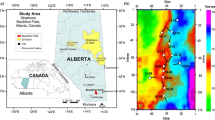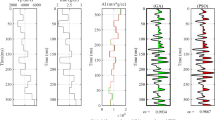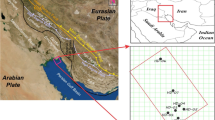Abstract
Seismic exploration is an oil exploration method by utilizing seismic information. Useful reservoir parameter information can be gained through inversion of seismic information to effectively carry out exploration work. Prestack data are characterized by large data size and rich information. Rich reservoir parameter information can be obtained through inversion of prestack data. Due to mass prestack seismic data, existing single computer environment cannot satisfy computation requirement of huge data size. Thus, an efficient and fast method is urgently needed to solve the inversion problem of prestack seismic big data. Since local optimum may be easily caught when genetic algorithm is used to optimize elastic parameters, the inversion effect is not obvious. In particular, the optimization effect for the density parameters is not good. An intelligent optimization algorithm is proposed in this paper for elastic parameter inversion of prestack seismic data. The algorithm improves genetic manipulation. The improved algorithm has been used for model trial for log data, and good inversion effect has been achieved. The inverted elastic parameters well fit with the log curve of the theoretical model. The improved algorithm effectively improves the inversion accuracy of density parameters. In this paper, the algorithm has been implemented on Spark model, and the results show that the parallel model can effectively reduce operation time of the algorithm.

























Similar content being viewed by others
Explore related subjects
Discover the latest articles, news and stories from top researchers in related subjects.References
Neidell NS (1986) Amplitude variation with offset. The Leading Edge 5(3):47–51
Li Shaopeng. The Study and Application of The Methods of AVO Seismic Parameter Inversion, Master thesis, China University of Petroleum, (in Chinese), China
Chen Jianjiang (2007) Study of Three-term AVO Inversion Method. Ph.D. thesis, China University of Petroleum, (in Chinese), China.
Berg E (1990) Simple convergent genetic algorithm for inversion of multiparameter data. In: Foster DJ, Keys RG (eds) SEG technical program expanded abstracts 1990. Society of Exploration Geophysicists, Tulsa, pp 1126–1128
Mallick S (1995) Model-based inversion of amplitude-variations-with-offset data using a genetic algorithm. Geophysics 60(4):939–954
Misra S, Sacchi MD (2008) Global optimization with model-space preconditioning: application to AVO inversion. Geophysics 73(5):R71–R82
Pengfei Lu, Changchun Yang, Aihua Guo et al (2008) Modified simulated annealing algorithm and its application in pre-stack inversion of reservoir parameters. Prog Geophys 23(1):104–109
Zhu T, Li XF, Li YQ et al (2011) Seismic scalar wave equation inversion based on an improved particle swarm optimization algorithm. Chin J Geophys 54(11):2951–2959 (in Chinese)
Ma XQ (2002) Simultaneous inversion of prestack seismic data for rock properties using simulated annealing. Geophysics 67(6):1877–1885
Buland A, Omre H (2003) Bayesian linearized AVO inversion. Geophysics 68(1):185–198
Mogensen S (2001) Artificial neural networks solutions to AVO inversion problems. In: Calandra H, Khoury A, Bothorel F, Vezolles P (eds) SEG technical program expanded abstracts 2001. Society of Exploration Geophysicists, Tulsa, pp 316–319
Agarwal A, Sain K, Shalivahan S (2016) Travel time and constrained AVO inversion using FDR PSO. In: Waters OT (ed) SEG technical program expanded abstracts 2016. Society of Exploration Geophysicists, Tulsa, pp 577–581
Li G, You J, Liu X (2015) Support Vector Machine (SVM) based prestack AVO inversion and its applications. J Appl Geophys 120:60–68
Soupios P, Akca I, Mpogiatzis P, Basokur AT, Papazachos C (2011) Applications of hybrid genetic algorithms in seismic tomography. J Appl Geophys 75(3):479–489
Porsani MJ, Stoffa PL, Sen MK, Chunduru R, Wood WT (1993) A combined genetic and linear inversion algorithm for seismic waveform inversion. In: Kendall RR, Davis TL (eds) SEG technical program expanded abstracts 1993. Society of Exploration Geophysicists, Tulsa, pp 692–695
Priezzhev I, Shmaryan L, Bejarano G (2008) Nonlinear multitrace seismic inversion using neural network and genetic algorithm-” Genetic Inversion. In: Extended abstract, EAGE conference, Saint Petersburg
Junyu B, Zilong X, Yunfei X, Tianshou X (2014) Nonlinear hybrid optimization algorithm for seismic impedance inversion. In: Beijing 2014 international geophysical conference & exposition, Beijing, China, 21–24 April 2014, (pp 541–544). Society of Exploration Geophysicists and Chinese Petroleum Society
Wang L P. Study on intelligent optimization algorithm with application to prestack AVO nonlinear inversion. Ph.D. thesis, China University of Geosciences, (in Chinese), China
Yan Z, Gu HM, Zhao XM (2009) Non-linear AVO inversion based on ant colony algorithm. Oil Geophys Prospect 44(6):700–702 (in Chinese)
Yin C, Xie GS (2001) Seismic inversion and non-linear stochastic optimistic algorithms. Comput Tech Geophys Geochem Explor 23(1):6–10 (in Chinese)
Dean J, Ghemawat S (2008) MapReduce: simplified data processing on large clusters. Commun ACM 51(1):107–113
Cui L (2014) Parallel PSO in Spark (Master’s thesis, University of Stavanger, Norway)
Wang ZY, Wang HJ et al (2015) Ant colony optimization algorithm based on Spark. J Comput Appl 35(10):2777–2780 (in Chinese)
Liu ZS, Pang ZS (2016) Research on parallel SVM algorithm based on Spark. Comput Sci 43(5):238–242 (in Chinese)
Xu ZH, Zhao JW et al (2017) Study of parallel genetic algorithm using travelling salesman problem. Appl Res Comput 34(7):2080–2083 (in Chinese)
Huang JL, Li QC et al (2010) Relative wave impedances inversion based on distributed parallel genetic algorithm. J Northwest University (Nat Sci Ed) 40(5):855–859 (in Chinese)
ZoeppritzK E (1919) On the reflection and propagation of seismic waves. Gottinger Nachrichten 1:66–84
Liu B, Wang L, Jin YH (2007) An effective PSO-based memetic algorithm for flow shop scheduling. IEEE Trans Syst Man Cybern Part B (Cybern) 37(1):18–27
Wang L, Pan QK, Suganthan PN, Wang WH, Wang YM (2010) A novel hybrid discrete differential evolution algorithm for blocking flow shop scheduling problems. Comput Op Res 37(3):509–520
Zhou A, Qu BY, Li H, Zhao SZ, Suganthan PN, Zhang Q (2011) Multiobjective evolutionary algorithms: A survey of the state of the art. Swarm Evolut Comput 1(1):32–49
Gong W, Cai Z (2013) Parameter extraction of solar cell models using repaired adaptive differential evolution. Solar Energy 94:209–220
Gong M, Cai Q, Chen X, Ma L (2014) Complex network clustering by multiobjective discrete particle swarm optimization based on decomposition. IEEE Trans Evolut Comput 18(1):82–97
Tang K, Peng F, Chen G, Yao X (2014) Population-based algorithm portfolios with automated constituent algorithms selection. Inf Sci 279:94–104
Gong W, Zhou A, Cai Z (2015) A multioperator search strategy based on cheap surrogate models for evolutionary optimization. IEEE Trans Evolut Comput 19(5):746–758
Zhou A, Sun J, Zhang Q (2015) An estimation of distribution algorithm with cheap and expensive local search methods. IEEE Trans Evolut Comput 19(6):807–822
Gong W, Yan X, Liu X, Cai Z (2015) Parameter extraction of different fuel cell models with transferred adaptive differential evolution. Energy 86:139–151
Wang L, Ni H, Yang R, Pardalos PM, Du X, Fei M (2015) An adaptive simplified human learning optimization algorithm. Inf Sci 320:126–139
Gong M, Liu J, Li H, Cai Q, Su L (2015) A multiobjective sparse feature learning model for deep neural networks. IEEE Trans Neural Netw Learn Syst 26(12):3263–3277
Gong W, Cai Z, Liang D (2015) Adaptive ranking mutation operator based differential evolution for constrained optimization. IEEE Trans Cybern 45(4):716–727
Zhou A, Zhang Q (2016) Are all the subproblems equally important? Resource allocation in decomposition-based multiobjective evolutionary algorithms. IEEE Trans Evolut Comput 20(1):52–64
Yan X, Wu Q, Sheng VS (2016) A double weighted Naive Bayes with niching cultural algorithm for multi-label classification. Int J Pattern Recognit Artif Intell 30(06):1650013
Tang K, Yang P, Yao X (2016) Negatively correlated search. IEEE J Sel Areas Commun 34(3):542–550
Wu Q, Liu H, Yan X (2016) Multi-label classification algorithm research based on swarm intelligence. Clust Comput 19(4):2075–2085
Deng J, Wang L (2017) A competitive memetic algorithm for multi-objective distributed permutation flow shop scheduling problem. Swarm Evolut Comput 32:121–131
Yan X, Liu H, Zhu Z, Wu Q (2017) Hybrid genetic algorithm for engineering design problems. Clust Comput 20(1):263–275
Tang K, Wang J, Li X, Yao X (2017) A scalable approach to capacitated arc routing problems based on hierarchical decomposition. IEEE Trans Cybern 47(11):3928–3940
Yan X, Sun J, Hu C (2017) Research on contaminant sources identification of uncertainty water demand using genetic algorithm. Clust Comput 20(2):1007–1016
Gong W, Wang Y, Cai Z, Yang S (2017) A weighted biobjective transformation technique for locating multiple optimal solutions of nonlinear equation systems. IEEE Trans Evolut Comput 21(5):697–713
Wu Q, Wang L, Zhu Z (2017) Research of pre-stack AVO elastic parameter inversion problem based on hybrid genetic algorithm. Clust Comput 20(4):3173–3783
Yan X, Song T, Wu Q (2017) An improved cultural algorithm and its application in image matching. Multimed Tools Appl 76(13):14951–14968
Wu Q, Zhu Z, Yan X (2017) Research on the parameter inversion problem of prestack seismic data based on improved differential evolution algorithm. Clust Comput 20(4):2881–2890
Yan X, Zhao J, Hu C, Zeng D (2017) Multimodal optimization problem in contamination source determination of water supply networks. Swarm Evolut Comput. https://doi.org/10.1016/j.swevo.2017.05.010
Yan X, Gong W, Wu Q (2017) Contaminant source identification of water distribution networks using cultural algorithm. Concur Comput Pract Exp. https://doi.org/10.1002/cpe.4230
Yan X, Zhu Z, Li T (2017) Pollution source localization in an urban water supply network based on dynamic water demand. Environ Sci Pollut Res. https://doi.org/10.1007/s11356-017-0516-y
Yan X, Zhu Z, Wu Q (2018) Intelligent inversion method for pre-stack seismic big data based on MapReduce. Comput Geosci 110:81–89
Zaharia M, Chowdhury M, Das T, Dave A, Ma J, McCauley M, Stoica I (2012) Resilient distributed datasets: a fault-tolerant abstraction for in-memory cluster computing. In: Proceedings of the 9th USENIX conference on networked systems design and implementation. USENIX Association, pp 2–2
Zaharia M, Chowdhury M, Das T, Dave A, Ma J, Mccauley M, Stoica I (2012) Fast and interactive analytics over Hadoop data with Spark. USENIX Login 37(4):45–51
Acknowledgments
This paper is supported by Natural Science Foundation of China. (Nos. 61673354 and 61573324), the Fundamental Research Funds for the Central Universities, China University of Geosciences (Wuhan), the State Key Lab of Digital Manufacturing Equipment and Technology (DMETKF2018020) and the State Key Laboratory of Intelligent Control and Decision of Complex Systems.
Author information
Authors and Affiliations
Corresponding author
Ethics declarations
Conflict of interest
The authors declare that there is no conflict of interest regarding the publication of this paper.
Rights and permissions
About this article
Cite this article
Yan, X., Zhu, Z., Hu, C. et al. Spark-based intelligent parameter inversion method for prestack seismic data. Neural Comput & Applic 31, 4577–4593 (2019). https://doi.org/10.1007/s00521-018-3457-6
Received:
Accepted:
Published:
Issue Date:
DOI: https://doi.org/10.1007/s00521-018-3457-6




